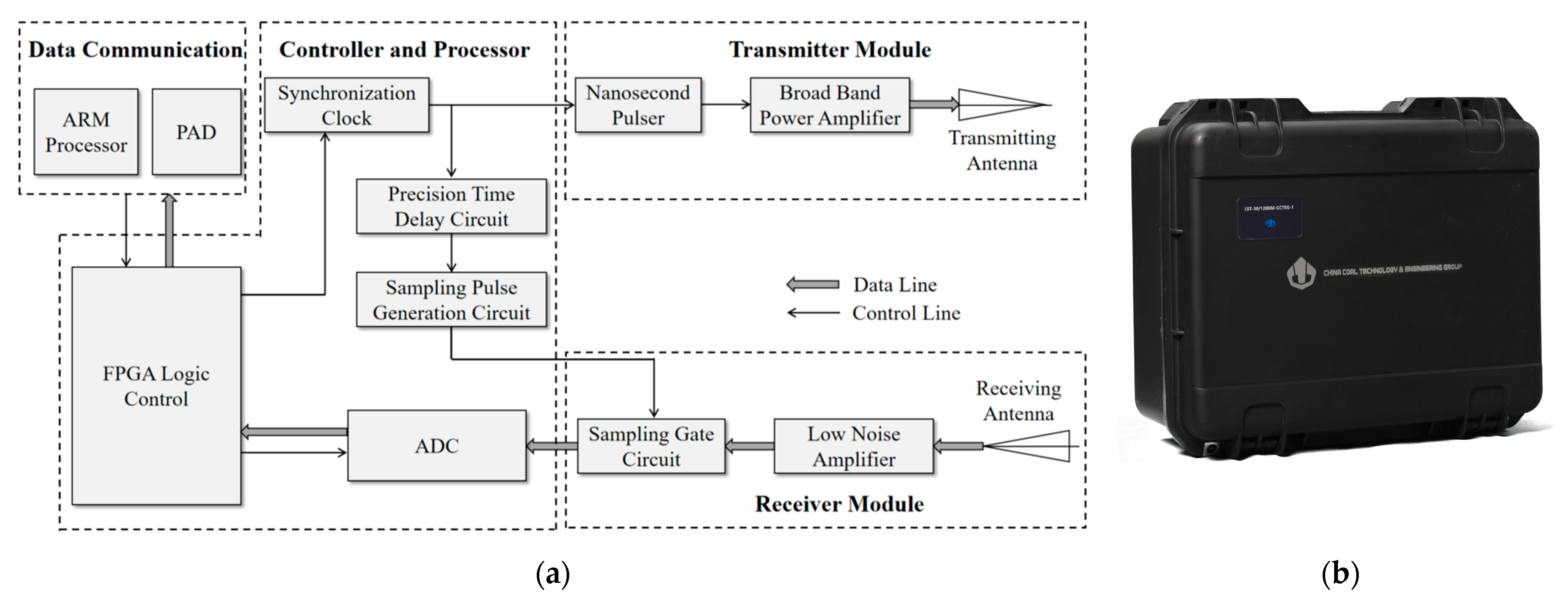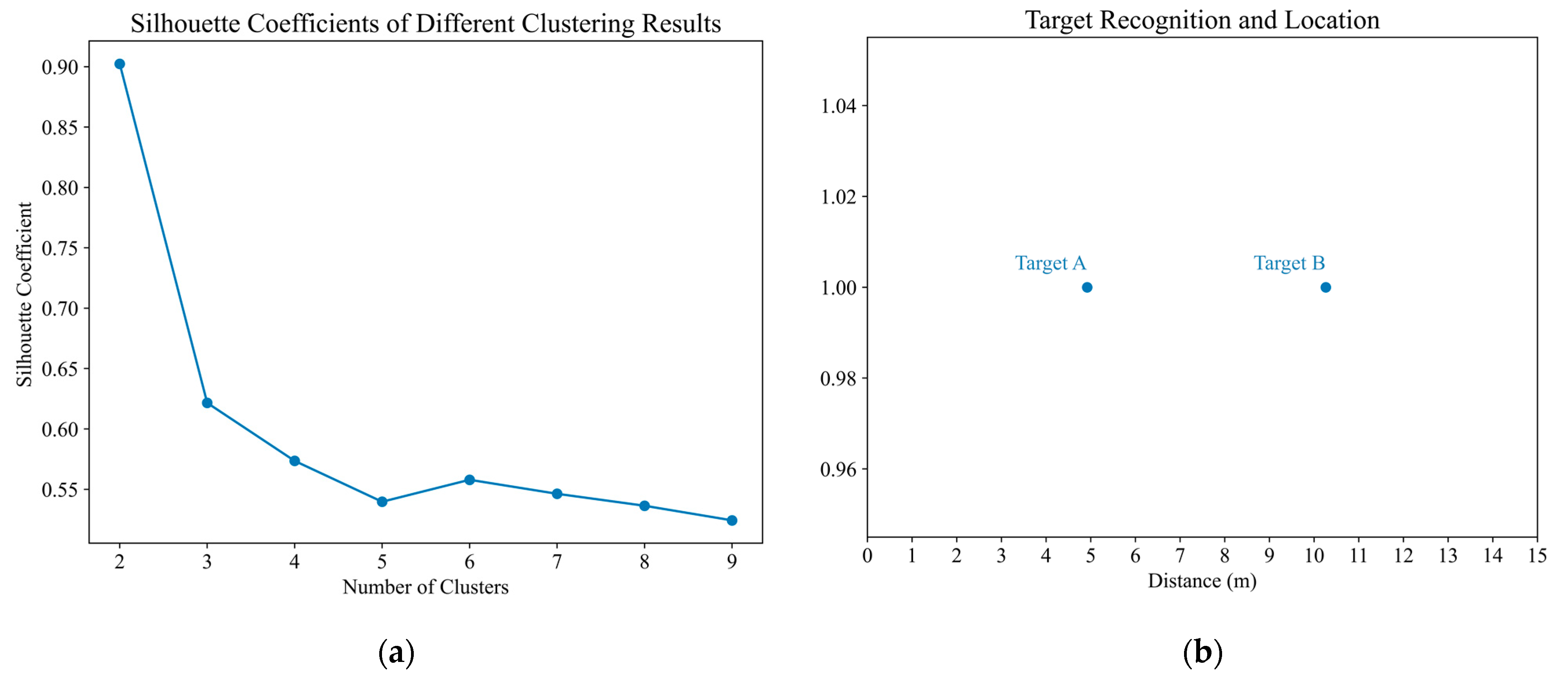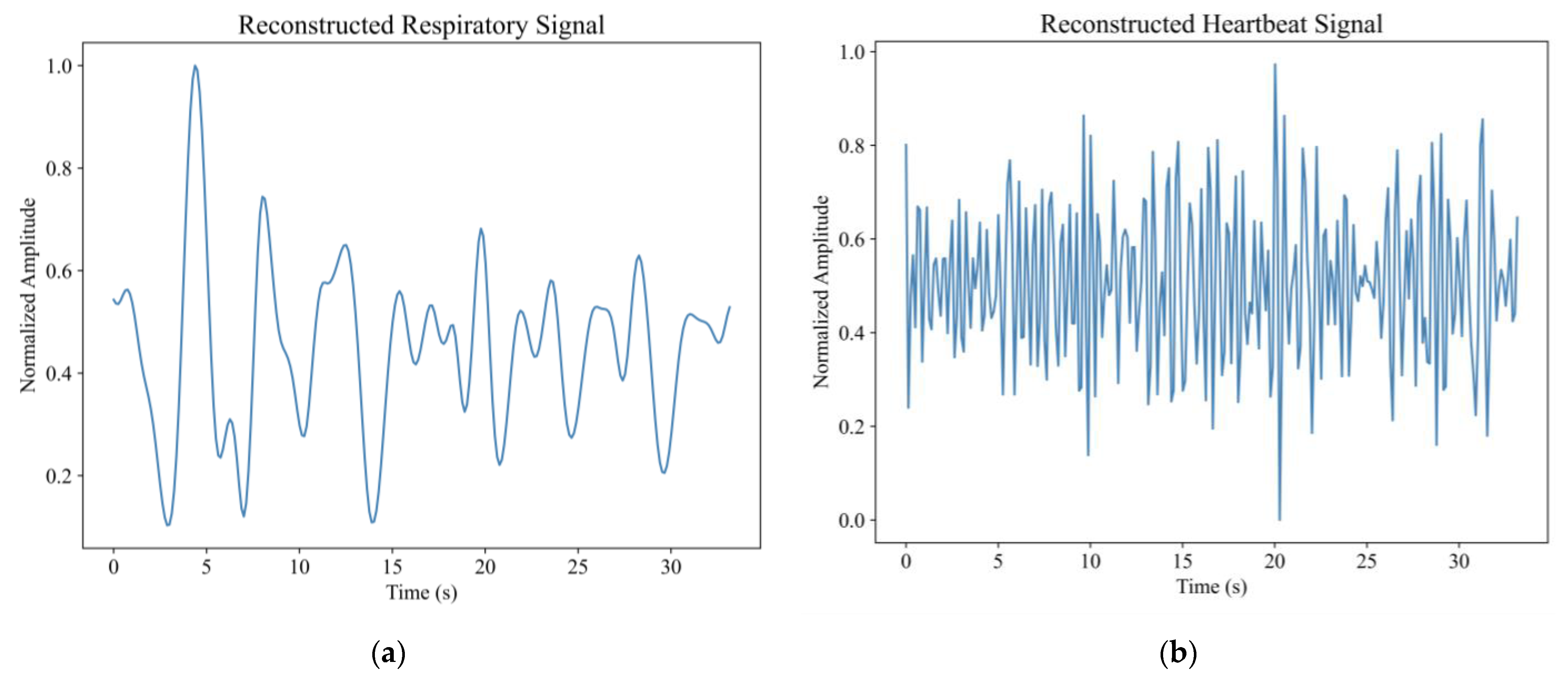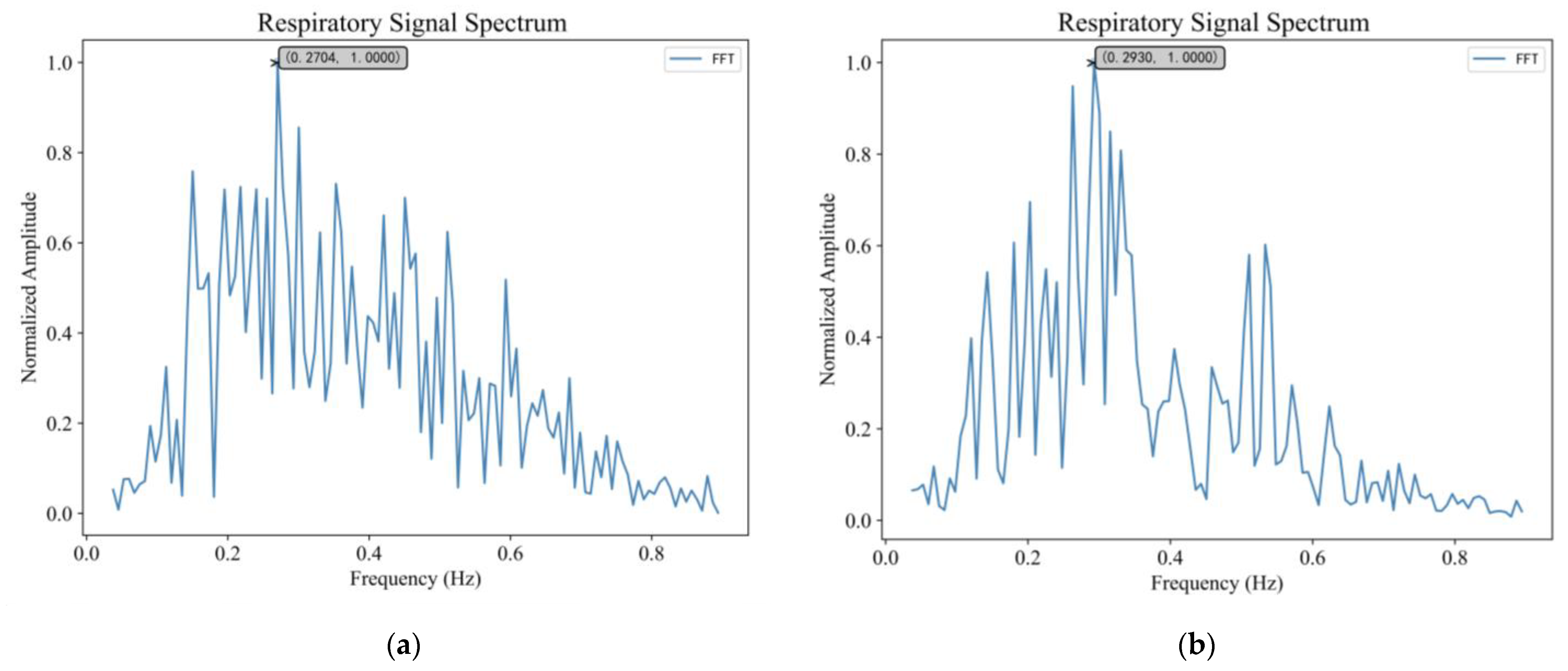A Multi-Target Localization and Vital Sign Detection Method Using Ultra-Wide Band Radar
Abstract
1. Introduction
2. Life Detection Model
3. Proposed Detection Method
3.1. Signal Preprocessing
3.2. Target Recognition and Location
3.3. Extraction of Vital Signs
3.3.1. Noise Reduction in Life Signal
3.3.2. Extraction of Respiratory and Heartbeat Frequency
4. Experiments
4.1. Construction of the UWB Radar System
4.2. Experimental Scheme Design
5. Results and Discussion
5.1. Performance of the Signal Preprocessing Method
5.2. Performance of Target Recognition and Location Method
5.3. Performance of Vital Signs Information Extraction Method
5.4. Further Verification of Performance
6. Conclusions
- (1)
- The target recognition and positioning method based on permutation entropy and K means++ clustering can successfully recognize multiple human targets in the environment, and accurately extract the location information of distant targets interfered with by the former targets. The average relative error of the distance measured by the method was 1.83%.
- (2)
- In this paper, an adaptive denoising method for vital signs extraction based on EEMD–WA was proposed, which could effectively filter the clutter signal and reconstruct the breathing and heartbeat signals of human targets. The respiratory frequency was obtained by FFT of the reconstructed respiratory signal, and the average relative error was 4.27%.
- (3)
- In order to solve the problem that existing methods cannot effectively extract heartbeat information, this paper proposed a heartbeat frequency extraction method based on PSO-SR, which can successfully extract the heartbeat frequency of each target in the environment, and the average relative error was 6.23%.
Author Contributions
Funding
Institutional Review Board Statement
Informed Consent Statement
Data Availability Statement
Conflicts of Interest
References
- Siddiqui, H.U.R.; Saleem, A.A.; Bashir, I.; Zafar, K.; Rustam, F.; Diez, I.D.L.T.; Dudley, S.; Ashraf, I. Respiration-based COPD detection using UWB radar incorporation with machine learning. Electronics 2022, 11, 2875. [Google Scholar] [CrossRef]
- Liu, S.; Qi, Q.; Cheng, H.; Sun, L.; Zhao, Y.; Chai, J. A vital signs fast detection and extraction method of UWB radar based on SVD. Sensors 2022, 22, 1177. [Google Scholar] [CrossRef] [PubMed]
- Jing, Y.; Qi, F.; Yang, F.; Cao, Y.; Zhu, M.; Li, Z.; Lei, T.; Xia, J.; Wang, J.; Lu, G. Respiration detection of ground injured human target using UWB radar mounted on a hovering UAV. Drones 2022, 6, 235. [Google Scholar] [CrossRef]
- Husaini, M.; Kamarudin, L.M.; Zakaria, A.; Kamarudin, I.K.; Ibrahim, M.A.; Nishizaki, H.; Toyoura, M.; Mao, X. Non-contact breathing monitoring using sleep breathing detection algorithm (SBDA) based on UWB radar sensors. Sensors 2022, 22, 5249. [Google Scholar] [CrossRef] [PubMed]
- Minhhuy, L. Heart rate extraction based on eigenvalues using UWB impulse radar remote sensing. Sens. Actuators A Phys. 2020, 303, 111689. [Google Scholar]
- Yang, Z.; Cheng, J.; Qi, Q.; Li, X.; Wang, Y. A method of UWB radar vital detection based on time extraction of strong vital signs. J. Sens. 2021, 2021, 7294604. [Google Scholar] [CrossRef]
- Zhang, Y.; Li, X.; Qi, R.; Qi, Z.; Zhu, H. Harmonic multiple loop detection (HMLD) algorithm for not-contact vital sign monitoring based on ultra-wideband (UWB) radar. IEEE Access 2020, 8, 38786–38793. [Google Scholar] [CrossRef]
- Rittiplang, A.; Phasukkit, P.; Orankitanun, T. Optimal central frequency for non-contact vital sign detection using monocycle UWB radar. Sensors 2020, 20, 2916. [Google Scholar] [CrossRef]
- Shi, C.; Zheng, Z.; Pan, J.; Ni, Z.K.; Ye, S.; Fang, G. Multiple stationary human targets detection in through-wall UWB radar based on convolutional neural network. Appl. Sci. 2022, 12, 4720. [Google Scholar] [CrossRef]
- Yang, Z.; Ma, C.; Qi, Q.; Li, X.; Li, Y. Applications of TVF-EMD in Vital Signal Detection for UWB Radar. J. Sens. 2021, 2021, 2136614. [Google Scholar] [CrossRef]
- Yarovoy, A.G.; Ligthart, L.P.; Matuzas, J.; Levitaset, B. UWB radar for human being detection. IEEE Aerosp. Electron. Syst. Mag. 2008, 23, 36–40. [Google Scholar] [CrossRef]
- Shi, L.; Jiang, M.; Huang, L. Human status recognition method for the life detection radar based on the harmonic model. J. Xidian Univ. 2005, 32, 179–183. [Google Scholar]
- Yang, G.C.; Yu, H.M. Vital sign detection of ultra-wideband radar based on N peaks capture. J. Electron. Meas. Instrum. 2020, 34, 204–210. [Google Scholar]
- Zhao, G.; Liang, Q.; Durrani, T.S. An EMD based sense-through-foliage target detection UWB radar sensor networks. IEEE Access 2018, 6, 29254–29261. [Google Scholar] [CrossRef]
- Liang, X.; Zhang, H.; Ye, S.; Fang, G.; Gulliver, T.A. Improved denoising method for through-wall vital sign detection using UWB impulse radar. Digit. Signal Process. 2018, 74, 72–93. [Google Scholar] [CrossRef]
- Dou, M.W.; Zhang, W.W. Improved ranging method for life detection using ultra-wide band impulse radar. J. Eng. 2018, 10, 1375–1383. [Google Scholar] [CrossRef]
- Zhang, Z.; Zhang, X.; Lv, H.; Lu, G.H.; Jing, X.J.; Wang, J.Q. Human-target detection and surrounding structure estimation under a simulated rubble via UWB radar. IEEE Geosci. Remote Sens. Lett. 2013, 10, 328–331. [Google Scholar] [CrossRef]
- Wu, S.Y.; Tan, K.; Xia, Z.H.; Chen, J.; Meng, S.W.; Fang, G.Y. Improved human respiration detection method via ultra-wideband radar in through-wall or other similar conditions. IET Radar Sonar Navig. 2016, 10, 468–476. [Google Scholar] [CrossRef]
- Qi, Q.; Zhao, Y.; Zhang, L.; Yang, Z.; Sun, L.; Jia, X. Research on ultra-wideband radar echo signal processing method based on P-order extraction and VMD. Sensors 2022, 22, 6276. [Google Scholar] [CrossRef]
- Zhang, Y.; Jiao, T.; Jing, X.J.; Li, Z.; Li, S.; Yu, X.; Lv, H.; Zhang, Z.; Wang, J.Q. A detecting and identifying method for two stationary human targets using single-channel ultra-wideband radar. EURASIP J. Adv. Signal Process. 2012, 2012, 202. [Google Scholar] [CrossRef]
- Zhang, Y.; Ma, Y.; Yu, X.; Wang, P.; Lv, H.; Liang, F.; Li, Z.; Wang, J. A Coarse-to-Fine Detection and Localization Method for Multiple Human Subjects under Through-wall Condition Using a New Telescopic SIMO UWB Radar. Sens. Actuators A Phys. 2021, 332, 113064. [Google Scholar] [CrossRef]
- Ding, C.; Yan, J.; Zhang, L.; Zhao, H.; Hong, H.; Zhu, X. Noncontact multiple targets vital sign detection based on VMD algorithm. In Proceedings of the 2017 IEEE Radar Conference (RadarConf), Seattle, WA, USA, 8–12 May 2017; pp. 0727–0730. [Google Scholar]
- Amit, S.; Debalina, G. Accurate sensing of multiple humans buried under rubble using IR-UWB SISO radar during search and rescue. Sens. Actuators A Phys. 2022, 348, 113975. [Google Scholar]
- Liu, L.; Liu, Z.; Xie, H.; Barrowes, B.; Bagtzoglou, A.C. Numerical simulation of UWB impulse radar vital sign detection at an earthquake disaster site. Ad Hoc Netw. 2014, 13, 34–41. [Google Scholar] [CrossRef]
- Ren, L.Y.; Koo, Y.S.; Wang, H.F.; Wang, Y.Z.; Liu, Q.H.; Fathy, A.E. Noncontact multiple heartbeats detection and subject localization using UWB impulse doppler radar. IEEE Microw. Wirel. Compon. Lett. A Publ. IEEE Microw. Theory Tech. Soc. 2015, 25, 690–692. [Google Scholar] [CrossRef]
- Li, C. Non-Contract Estimation of Respiration and Heartbeat Rate Using Ultra-Wideband Signals; Virginia Polytechnic Institute and State University: Blacksburg, VA, USA, 2008. [Google Scholar]
- Bandt, C.; Pompe, B. Permutation entropy: A natural complexity measure for time series. Phys. Rev. Lett. 2002, 88, 174102. [Google Scholar] [CrossRef] [PubMed]
- Richman, J.S.; Moorman, J.R. Physiological time-series analysis using approximate entropy and sample entropy. Am. J. Physiol. Heart Circ. Physiol. 2000, 278, 2039–2049. [Google Scholar] [CrossRef]
- Liu, N.; Liu, B.; Wei, J.X.; Xi, C.G. A fault pattern recognition method for rolling bearing based on CEEMDAN and fuzzy entropy. J. Vibroeng. 2020, 22, 1326–1337. [Google Scholar] [CrossRef]
- Arthur, D.; Vassilvitskii, S. K-means++: The advantages of careful seeding. In Proceedings of the Eighteenth Annual ACM-SIAM Symposium on Discrete Algorithms, New Orleans, LA, USA, 7–9 January 2007; pp. 1027–1035. [Google Scholar]
- Zhang, J.W.; Qi, Q.J.; Cheng, H.F.; Sun, L.; Zhao, Y. Multi-target recognition and distance detection method based on PE-Kmeans++ and HOC algorithm for UWB radar. In Proceedings of the International Conference on Biometrics, Microelectronic Sensors, and Artificial Intelligence (BMSAI), Sanya, China, 25–27 March 2022. [Google Scholar]
- Wu, Z.; Huang, N.E. Ensemble empirical mode decomposition: A noise-assisted data analysis method. Adv. Adapt. Data Anal. 2011, 1, 1–41. [Google Scholar] [CrossRef]
- Rilling, G.; Flandrin, P.; Gonçalves, P. On empirical mode decomposition and its algorithms. In Proceedings of the IEEE-EURASIP Workshop on Nonlinear Signal and Image Processing (NSIP’03), Trieste, Italy, 8–11 June 2003. [Google Scholar]
- Zheng, Z.G. Empirical Mode Analysis and Wavelet Analysis and Its Application; China Meteorological Press: Beijing, China, 2010. [Google Scholar]
- Firdaus, S.M.; Arifin, A.; Abdullah, S.; Singh, S.S.K.; Md Nor, N. Detection of uniaxial fatigue stress under magnetic flux leakage signals using Morlet wavelet. Fract. Struct. Integr. Int. J. Ital. Group Fract. 2022, 16, 254–265. [Google Scholar] [CrossRef]
- He, L.F.; Zhou, X.C.; Zhang, T.Q. Stochastic resonance characteristic analysis of new potential function under Levy noise and bearing fault detection. Chin. J. Phys. 2018, 56, 538–560. [Google Scholar] [CrossRef]
- Qiao, Y.R.; Chen, J.L.; Hou, W. Bearing fault detection algorithm based on cuckoo algorithm to optimize stochastic resonance parameters. Electron. Meas. Technol. 2021, 44, 6. [Google Scholar]
- Zong, P.; Men, Y.B.; An, R.; Wang, H. Adaptive progressive learning stochastic resonance for weak signal detection. Meas. Sci. Technol. 2023, 34, 045008. [Google Scholar] [CrossRef]
- Shi, Y. A modified particle swarm optimizer. In Proceedings of the 1998 IEEE International Conference on Evolutionary Computation Proceedings, IEEE World Congress on Computational Intelligence (Cat. No. 98TH8360), Anchorage, AK, USA, 4–9 May 1998. [Google Scholar]
- Yang, D.X.; Hu, N.Q. Numerical simulations of stochastic resonance in weak signal detection. J. Natl. Univ. Def. Technol. 2003, 25, 91–94. [Google Scholar]















| Parameter | Numerical Value |
|---|---|
| Center frequency | 400 MHz ± 20 MHz |
| Pulse width | 2 ns |
| Fast time domain sampling frequency | 39 GHz |
| Slow time domain sampling frequency | 8 Hz |
| Reception sensitivity | −60 dBm |
| Equivalent sampling rate | 5 G Sa/s |
| No. | Volunteer | Gender | Height (cm) | Weight (kg) | Distance (m) |
|---|---|---|---|---|---|
| 1 | A | male | 176 | 70 | 5.0 |
| B | male | 179 | 75 | 10.0 | |
| 2 | A | male | 176 | 70 | 5.0 |
| C | female | 160 | 51 | 6.0 | |
| 3 | A | male | 176 | 70 | 3.0 |
| C | female | 179 | 51 | 6.0 | |
| B | male | 160 | 75 | 9.0 |
| No. | Volunteer | Target Number | Position (m) | |||
|---|---|---|---|---|---|---|
| Result | Truth Value | Result | Truth Value | Relative Error | ||
| 1. | A | 2 | 2 | 4.92 | 5.00 | 1.6% |
| B | 10.26 | 10.00 | 2.6% | |||
| 2. | A | 2 | 2 | 5.13 | 5.00 | 2.6% |
| B | 5.94 | 6.00 | 1.0% | |||
| 3. | A | 3 | 3 | 3.06 | 3.00 | 2.0% |
| C | 6.12 | 6.00 | 2.0% | |||
| B | 8.91 | 9.00 | 1.0% | |||
| No. | Volunteer | Respiratory Frequency (Hz) | Heartbeat Frequency (Hz) | ||||
|---|---|---|---|---|---|---|---|
| Result | Truth Value | Relative Error | Result | Truth Value | Relative Error | ||
| 1. | A | 0.2704 | 0.28 | 3.4% | 1.6391 | 1.53 | 7.1% |
| B | 0.2930 | 0.32 | 8.4% | 1.8647 | 1.67 | 11.7% | |
| 2. | A | 0.2929 | 0.31 | 5.5% | 1.4862 | 1.42 | 4.7% |
| B | 0.3358 | 0.33 | 1.8% | 1.4281 | 1.41 | 1.3% | |
| 3. | A | 0.2897 | 0.29 | 0.1% | 1.4603 | 1.40 | 4.3% |
| C | 0.2739 | 0.29 | 5.6% | 1.4921 | 1.42 | 5.1% | |
| B | 0.2846 | 0.30 | 5.1% | 1.7724 | 1.62 | 9.4% | |
Disclaimer/Publisher’s Note: The statements, opinions and data contained in all publications are solely those of the individual author(s) and contributor(s) and not of MDPI and/or the editor(s). MDPI and/or the editor(s) disclaim responsibility for any injury to people or property resulting from any ideas, methods, instructions or products referred to in the content. |
© 2023 by the authors. Licensee MDPI, Basel, Switzerland. This article is an open access article distributed under the terms and conditions of the Creative Commons Attribution (CC BY) license (https://creativecommons.org/licenses/by/4.0/).
Share and Cite
Zhang, J.; Qi, Q.; Cheng, H.; Sun, L.; Liu, S.; Wang, Y.; Jia, X. A Multi-Target Localization and Vital Sign Detection Method Using Ultra-Wide Band Radar. Sensors 2023, 23, 5779. https://doi.org/10.3390/s23135779
Zhang J, Qi Q, Cheng H, Sun L, Liu S, Wang Y, Jia X. A Multi-Target Localization and Vital Sign Detection Method Using Ultra-Wide Band Radar. Sensors. 2023; 23(13):5779. https://doi.org/10.3390/s23135779
Chicago/Turabian StyleZhang, Jingwen, Qingjie Qi, Huifeng Cheng, Lifeng Sun, Siyun Liu, Yue Wang, and Xinlei Jia. 2023. "A Multi-Target Localization and Vital Sign Detection Method Using Ultra-Wide Band Radar" Sensors 23, no. 13: 5779. https://doi.org/10.3390/s23135779
APA StyleZhang, J., Qi, Q., Cheng, H., Sun, L., Liu, S., Wang, Y., & Jia, X. (2023). A Multi-Target Localization and Vital Sign Detection Method Using Ultra-Wide Band Radar. Sensors, 23(13), 5779. https://doi.org/10.3390/s23135779





